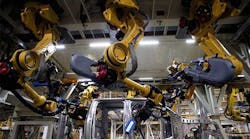Manufacturing’s Technology Lag Is Becoming a National Problem
The pandemic has been a wakeup call for American manufacturers. Amid rampant supply chain disruption, the need to re-shore production and compete on an international scale has become more important than ever. There’s a reason that one of President Biden’s first initiatives was a revitalized “Buy American” campaign.
Yet despite the vast potential of U.S. manufacturers, we won’t get there without first ratcheting up investment in Industry 4.0 technologies. Our competitors already have, with China leading the way on industrial robotics and Germany lapping the U.S. in manufacturing-related research, as just two examples.
Some big U.S. manufacturers have certainly gotten the memo on advanced technologies. But it’s still a problem for small and medium-sized enterprises (SMEs), many of whom, according to a recent MIT study, are stuck in a “low-wage, low-technology equilibrium.”
We’ve seen this play out in our own backyard: in Northeast Ohio, only 7% of firms use cobots effectively, only 10% make web-connected products, and only 18% are using automation profitably; in fact, investing in Industry 4.0 is at the bottom of the list for most of the region’s manufacturers.
Research that will soon be released by Team NEO, a business and economic development organization in Northeast Ohio, finds that while both the Northeast Ohio region and U.S. will see some recovery in manufacturing employment post-pandemic, it is not projected to fully recover to 2018 levels. However, with advances in technology, the sector’s total GDP is projected to grow 73% by 2025.
While there may be a significant cost and expertise barrier to undergoing technology transformation, especially for SMEs, the good news is that there are a number of practical, incremental steps manufacturers can take to begin their journeys. In MAGNET’s new blueprint for manufacturing in Northeast Ohio (MAGNET is a non-profit consulting group that collaborates with manufacturing CEOs, governments, community leaders, and educators) we outline how stakeholders can come together and make these transformations a reality.
Here’s how.
Drive Education and Awareness
For SMEs to really take the plunge, it helps for them to understand the benefits of Industry 4.0 adoption—and learn from “lighthouse” companies who lead the way. This may take the form of Industry 4.0 awareness and education programs and pilots (e.g., try-before-you-buy initiatives) that demonstrate pathways to smart manufacturing.
Collaborations among manufacturers, government, academia, community leaders and nonprofits can come together to provide this education and awareness. For instance, the Smart Manufacturing Cluster of Northeast Ohio powered by Team NEO provides local companies with an Industrial Internet of Things (IIoT) readiness assessment to help evaluate manufacturers’ digital maturity and readiness for IIoT implementation. And collaborative projects like our blueprint promote and showcase stories of leading companies that are using technology to hire workers, increase productivity and expand production.
Gojo Industries, a family-owned business that created Purell hand sanitizer, is one such example. During the pandemic, the company managed to boost production of Purell by 300% and bring on over 500 employees—all because it had made technology investments that automated production and digitized processes.
Remember, too, that it’s OK to take an incremental approach; as Stephanie Onderko, automation and systems director for supply chain at GOJO, told us, “You’re going to need champions, and you’re going to need buy-in to continue this journey. Show on a small scale what Industry 4.0 can do for your business and then expand from there. We learned things we didn’t even realize we were going to learn, and it has just kind of exploded from there.”
Find Innovative Ways to Overcome Financial Barriers
But education can only go so far. Manufacturers will need capital to invest in new technologies. And not all of them will have enough on hand to do so without taking substantial risks.
The good news is that financial barriers can be overcome. Grants, tax incentives, and loan-loss guarantee programs can help. So would President Biden’s proposed investment increases in Manufacturing Extension Partnerships, as well as vehicles like the Department of Defense’s industrial policy office and other forms of de-risking from government and non-market institutions.
Carla Macklin’s story serves as a positive example. In March of last year, Macklin, a consultant at MAGNET, decided to start a mask business. But she knew that to deliver high-quality local masks at a competitive price, she would need automation. Finding the machines to do so amid the pandemic was difficult enough – then she had to find a way to raise $1.8 million for them.
Through MAGNET and Team NEO, Macklin was connected to JobsOhio and received innovative funding in the form of a loan-loss guarantee. If the startup works, the government gets its money back and a share of the profits. If the technology or business fails, the government and startup share the losses.
“I think this loan model—sharing in both the upside and downside risk along with the company owners—is a really good model for the state to think about if they want innovation to thrive in certain sectors,” Macklin said.
Macklin was able to open Buckeye Mask Company in August 2020. The company secured a contract with the Ohio Bureau of Workers’ Compensation to produce 45,000 masks a day at its peak.
Invite New Players to Participate
In addition to transforming the country’s factories with technology, we need to attract more technology suppliers and startups into manufacturing regions to invent, commercialize and export digital manufacturing technologies themselves.
Working with local universities is a great way to start, whether it’s collaborating on industry-led research projects, launching an academy where students work on specific manufacturing problems while getting advanced degrees, or pursuing applied research centers with industry research partners.
Don Scipione, CEO of Roll-A-Rack, used partnerships like these to help develop his solar panel racking startup. He’s relying on NASA’s Glenn Research Center for confirmation of wind tunnel results, Case Western Reserve’s SDLE Research Center to evaluate weather corrosion issues and MAGNET for engineering design support. Together, these collaborations “are worth a million dollars,” he told me last year.
Re-establishing the U.S.’s manufacturing prowess starts with technology transformation and investment. To make it happen, though, we’ll need to collaborate to drive education and awareness, knock down financial barriers, and invite emerging technology players into more of our manufacturing regions.
Ethan Karp is president and CEO of the Manufacturing Advocacy and Growth Network (MAGNET). Bill Koehler is CEO of Team Neo.




